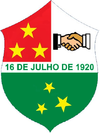Trindade, Goiás
| Trindade | |||
|---|---|---|---|
| Municipality | |||
|
|||
 Location in Goiás state |
|||
| Location in Brazil | |||
| Coordinates: 16°39′29″S 49°29′01″W / 16.65806°S 49.48361°WCoordinates: 16°39′29″S 49°29′01″W / 16.65806°S 49.48361°W | |||
| Country |
|
||
| Region | Central-West Region | ||
| State | Goiás | ||
| Microregion | Goiânia Microregion | ||
| Area | |||
| • Total | 713.2 km2 (275.4 sq mi) | ||
| Elevation | 756 m (2,480 ft) | ||
| Population (2007) | |||
| • Total | 97,491 | ||
| • Density | 140/km2 (350/sq mi) | ||
| Time zone | BRT/BRST (UTC-3/-2) | ||
| Postal code | 75380-000 | ||
| Website | www |
||
Trindade is a city and municipality in Goiás state, Brazil. It is famous for the religious celebrations held there in July and is now the third most important pilgrimage site in Brazil.
On the west side of the city is a purpose-built raceway where, in 2014, the city hosted a , race.
Trindade is part of the Goiânia Microregion, which has over one million six hundred thousand inhabitants. It is located approximately 30 km. west of Goiânia, to which it is connected by a four-lane highway, GO-060.
Although Trindade became a city in 1943, its origins go back to 1840, when, according to local folklore, in a small village called Barro Preto, Constantino Xavier and his wife Ana Rosa found in their fields a small clay medallion showing the Holy Trinity crowning the Virgin Mary.
Soon a palm covered chapel was raised to be later replaced by a mortar chapel covered with tiles. Lands were donated by local farmers and a religious shrine began to take form.
Followers decided to embellish the simple clay medallion and it was taken to Pirenópolis to be worked on by the greatest artist of the region. The original clay medallion returned to Trindade substituted by a wooden representation and that is what is seen by pilgrims today in the main church.
Today this statue is displayed in the basilica of Trindade, the only basilica in the world dedicated to God, the father figure of the Catholic trinity.
Every year starting on the first Sunday of July thousands of pilgrims arrive in Trindade to pray to the "Divino Pai Eterno" (Divine Holy Father). The festival lasts for fifteen days and attracts an estimated population of close to one million visitors, one of the largest religious festivals in Brazil.
From Goiânia to Trindade the distance is 18 kilometers and the road is called a Rodovia dos Romeiros (The highway of the Pilgrims). It is lined with outdoors lit up by spotlights showing the stages of the cross, the Via Sacra, painted by a local artist Omar Souto. The artist incorporated contemporary events into the pictures, for example, Leide das Neves, victim of the accident with Cesio 137 in Goiânia in 1987.
The highlight of the celebration is a procession of several hundred "carros de boi" (ox carts), from all parts of the state. In 2003 alone 230 ox carts made their way through the streets of the town accompanied by almost two thousand riders. Close to one hundred thousand people witness the parade, perhaps the largest parade of ox carts in the world. See City of Trindade for photos.
...
Wikipedia



